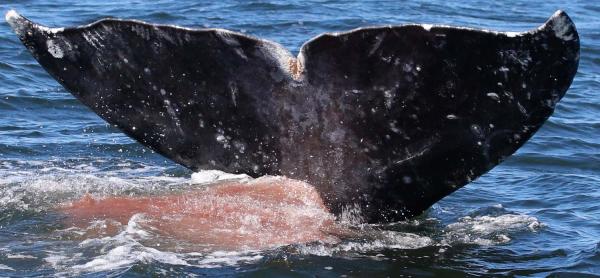This student story was published as part of the 2023 NASW Perlman Virtual Mentoring Program organized by the NASW Education Committee, providing science journalism practice and experience for undergraduate and graduate students.
Story by Mackenzie White
Mentored and edited by Saima Sidik
When gray whales chow down on plankton, there’s a hidden item on the menu: plastic.
In recent decades, microplastics — or pieces of plastic smaller than 5 millimeters across — have infiltrated diverse ecosystems, leaching toxins into the animals that eat them. When plankton consume microplastics, these pollutants do double duty, accumulating in the plankton and in the whales that prey on them.
A single gray whale may swallow as much as 21 million microparticles per day through the food they eat, a recent study showed. “The sheer numbers we estimated are insane,” said marine ecologist Leigh Torres from Oregon State University, who led the study. “It was shocking.”
Unpacking the Plastic Puzzle
Everything from clothing to carpets can shed microplastics, which can then take centuries to degrade. Along coastlines, these particles can draw the eye as minuscule, colorful fragments intermingled with the sand. In the ocean, microplastics have deadly consequences for marine life, from disrupting the microbiomes of seabirds to stunting the growth of mussels.
Gray whales specialize in bottom feeding, primarily relying on nutrients from zooplankton — a large group of organisms that includes tiny crustaceans and other small animals such as copepods and krill.
Analyzing 26 zooplankton samples collected from whale feeding areas, the researchers detected microplastics in all of them. By calculating the caloric needs of pregnant and lactating gray whales (categories for which researchers have the most information), they concluded that an individual swallows 6.5 to 21 million particles per day. Lined up end to end, these plastic particles could form a trail up to the length of 340 football fields.
“Exactly how microplastics move through ecosystems is a hot topic for researchers right now,” said Bonnie Hamilton, an ecotoxicologist at the University of Toronto who was not involved in the work. Because the study shows that predators are consuming plastic through their prey, it provides compelling evidence that microparticles are systemically moving up the food web, she said.
The Proof is in the Poop
In addition to zooplankton, gray whales consume microplastics from other sources like water and sediment, Torres explained.
To explore these additional ingested microplastics, Torres and her team examined fecal samples they collected from the whales. Poop can reveal a lot about an animal — from its hormone levels to its genetic identity — but it’s challenging to gather because it disperses as clouds of tiny particulate matter.
 Researchers collected and analyzed whale poop, revealing staggering microplastic consumption. Credit: IndividuWhale. Creator: Lisa Hildebrand
Researchers collected and analyzed whale poop, revealing staggering microplastic consumption. Credit: IndividuWhale. Creator: Lisa Hildebrand
Employing drones to track the whales and closely following them in boats, the researchers scanned the water, poised for the telltale reddish-brown plumes of waste to appear. As soon as these distinctive clouds materialized, the team shifted into action, positioning themselves behind the whale to gather the biological gold with fine mesh nets. Affectionately referring to themselves as “team pooper scooper,” the researchers captured 5 samples from 4 individual whales for microplastic analysis.
Along with microparticles similar to those in zooplankton, the feces also contained larger plastic particles. This suggests that whales also eat microplastics from the water and sediment they filter in search of zooplankton, raising concerns about other major sources of pollution.
In addition to releasing toxins, microplastics can interfere with zooplankton’s feeding capacity. Just as snacking on nutrient-poor sweets can satisfy one's hunger, the consumption of microplastics can trigger a false sense of fullness in zooplankton. Dining on plastic "snacks" that deceive their appetites, they may prematurely abandon their search for crucial nutrients.
This dietary disruption transforms plankton into vessels of pollution, leading to ecological problems that ripple up the food web. When giant filter-feeders like whales ingest these microplastic-laden prey, they inadvertently swap vital nutrients for plastic constituents and risk health consequences like malnourishment. Torres and her team are now turning their attention to determining how much harm microplastics could be doing to these predators and their prey.
If microplastics harm gray whale populations, the entire ecosystem could suffer, explained Lisa Hildebrand, an author of the study and doctoral student in marine ecology at Oregon State University. “We don’t know exactly what would happen, but there are so many important species that benefit from the whales,” she said.
Whales play a critical role in the nutrient cycle, acting as the ocean's gardeners by producing and distributing nutrients like nitrogen and iron that fertilize the sea and support diverse marine life.
The findings are a stark reminder of the pervasiveness of microplastics in Earth’s oceans, collecting not only in remote garbage patches but also in beloved bays, beaches, and baleen whales. “They’re everywhere,” Torres said. And because human behavior caused this crisis, “we need to reckon with that.”
Main Image Caption: Scarlett (also known as “Scarback”) is a gray whale researchers have observed along the coast of the Pacific Northwest since 1996. She is easily identified by the large, distinctive scar on her back. Credit: IndividuWhale. Creator: Erik Urdahl. Copyright: 2017 Urdahl Photo
Mackenzie White is a PhD candidate studying planetary science. She works on lunar and martian NASA missions to explore what planets are made of and how they form. She combines her passions for science and art through freelance journalism and graphic design, covering topics ranging from space rocks to marine animals. You can find her on Twitter @MackenzieMtn, her website mackenzienwhite.com, or email her at mnwhite0001@gmail.com.
The NASW Perlman Virtual Mentoring program is named for longtime science writer and past NASW President David Perlman. Dave, who died in 2020 at the age of 101 only three years after his retirement from the San Francisco Chronicle, was a mentor to countless members of the science writing community and always made time for kind and supportive words, especially for early career writers. Contact NASW Education Committee Co-Chairs Czerne Reid and Ashley Yeager and Perlman Program Coordinator Courtney Gorman at mentor@nasw.org. Thank you to the many NASW member volunteers who spearhead our #SciWriStudent programming year after year.
Founded in 1934 with a mission to fight for the free flow of science news, NASW is an organization of ~ 2,600 professional journalists, authors, editors, producers, public information officers, students and people who write and produce material intended to inform the public about science, health, engineering, and technology. To learn more, visit www.nasw.org





